The financial stability of a nation's banking system is crucial for economic growth and the well-being of its citizens. Recently, a report from a major consulting firm, Klaros Group, has brought to light that approximately 7% of U.S. banks are at risk of failure. This revelation has raised concerns among investors, policymakers, and the public at large.
The analysis evaluated around 4,000 U.S. banks, identifying 282 that face risks from commercial real estate loans and potential losses due to higher interest rates. These banks are predominantly smaller institutions, each with assets totaling less than $10 billion. The challenges faced by these banks are significant, as they could have subtle yet profound effects on the communities they serve and their customers.
The potential failure of these banks could lead to reduced investment in new branches, technology, or staff, directly affecting the services provided to customers. Moreover, the former chair of the U.S. Federal Deposit Insurance Corporation (FDIC), Sheila Bair, has highlighted that while individual deposits are generally protected up to $250,000 per depositor per insured bank, the indirect consequences of small bank failures could still impact communities and customers.
The report comes at a time when the U.S. banking system has already shown signs of strain. For instance, the significant losses reported by New York Community Bank and Softbank Group indicate the need for potential intervention. Additionally, the recent seizure of Republic First Bank, which is estimated to cost the FDIC approximately $667 million, underscores the fragility of the situation.
As the regional bank crisis appears to be far from over, it is essential for regulators, banks, and customers to remain vigilant. The diminished cash reserves and repeated government interventions signal that the banking sector has vulnerabilities that could seriously affect the economy if not addressed promptly.
The road ahead will require a concerted effort from all stakeholders to ensure the resilience of the banking system. This may involve regulatory changes, strategic mergers and acquisitions, or innovative financial products that can provide stability in times of uncertainty.










